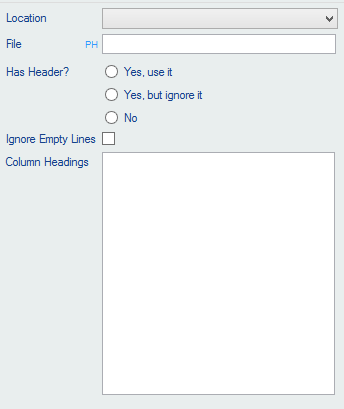A Comma Separated Variable (CSV) file is a text file that contains rows of data in a specific format. They are often used as the etxt file saved version of a Microsoft Excel worksheet. Each line (except the optional heading line) represents a single record, and each field is separated on the line by a comma.
A csv data group includes data from a CSV file into a DSD
by reading each line in the text file as a record, based on certain rules that you can set regarding the content and format.
Where is the CSV file?
First, specify the location and file to open for the data. The location is chosen from a list of Sources of type “loc” set up using fAdmin. The file is an entered file name (or partial path and file name) within the chosen location. Placeholders may be used with the entered file name to include user entered values or values from other data groups. For example, an earlier data group may obtain a Client Id to be used in the file name of the appropriate CSV.
What does it contain?
A CSV typvial has a format like this:
Id,FirstName,Surname A001,John,Smith A002,Jane,Jones A003,Sara,Brown
However, sometimes you may adapt the CSV even though you are unable to edit. You can do this by informing fSeries of format options:
Has Header
If your CSV has no header, the first line is real data. Alternatively it has a header but you wish to ignore it (you are able to specify the column headings below). Check “Yes,use it”, “Yes, ignore it” or “No”.
Ignore Empty Lines
Sometimes a CSV has completely blank lines. These will be interpretted by fSeries as real records (with all fields blank) unless you check the “Ignore empty lines” option.
Column Headings
Whether your CSV has a heading row or not (or you chose to ignore it) you can specify your own field names.
In the text box enter a column heading (field name) for each column in your CSV. Leave a line blank if you want to use the default for that field.
When the data group is processed, fSeries will check and correct invalid names and also fill in for any missing columns with “col” followed by the columns zero-based number.


